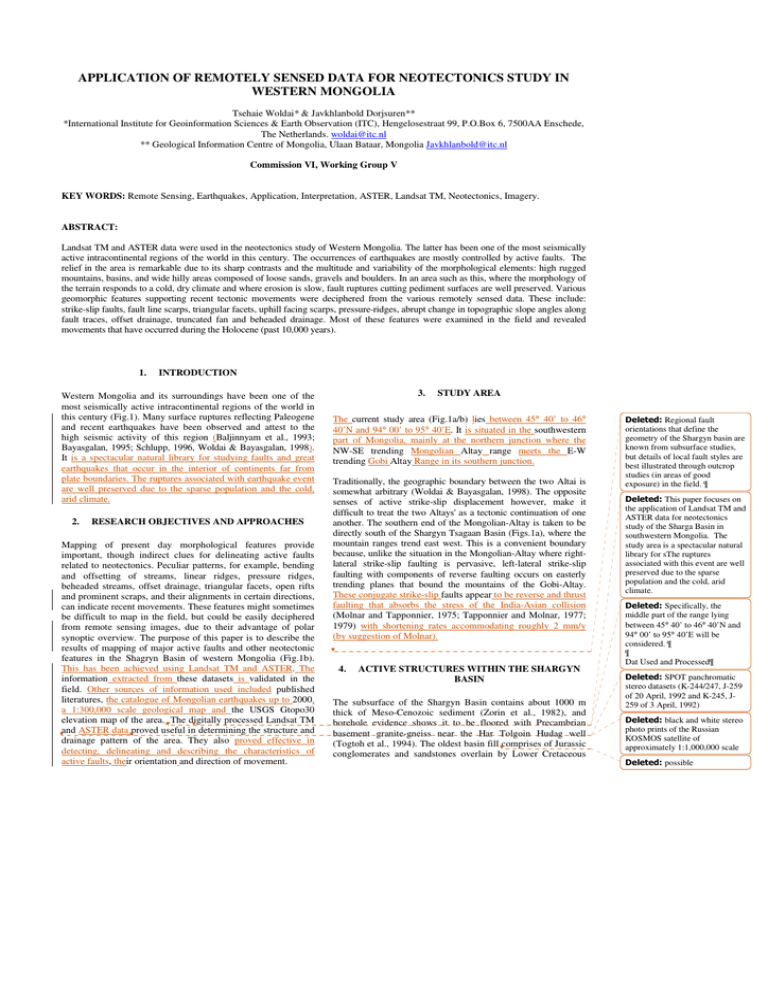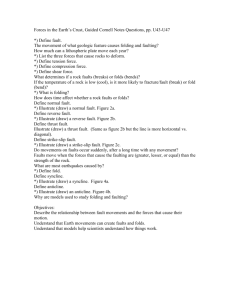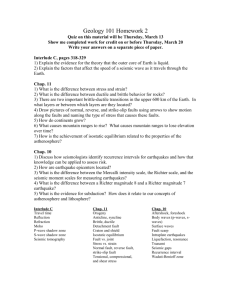APPLICATION OF REMOTELY SENSED DATA FOR NEOTECTONICS STUDY IN WESTERN MONGOLIA
advertisement

APPLICATION OF REMOTELY SENSED DATA FOR NEOTECTONICS STUDY IN WESTERN MONGOLIA Tsehaie Woldai* & Javkhlanbold Dorjsuren** *International Institute for Geoinformation Sciences & Earth Observation (ITC), Hengelosestraat 99, P.O.Box 6, 7500AA Enschede, The Netherlands. woldai@itc.nl ** Geological Information Centre of Mongolia, Ulaan Bataar, Mongolia Javkhlanbold@itc.nl Commission VI, Working Group V KEY WORDS: Remote Sensing, Earthquakes, Application, Interpretation, ASTER, Landsat TM, Neotectonics, Imagery. ABSTRACT: Landsat TM and ASTER data were used in the neotectonics study of Western Mongolia. The latter has been one of the most seismically active intracontinental regions of the world in this century. The occurrences of earthquakes are mostly controlled by active faults. The relief in the area is remarkable due to its sharp contrasts and the multitude and variability of the morphological elements: high rugged mountains, basins, and wide hilly areas composed of loose sands, gravels and boulders. In an area such as this, where the morphology of the terrain responds to a cold, dry climate and where erosion is slow, fault ruptures cutting pediment surfaces are well preserved. Various geomorphic features supporting recent tectonic movements were deciphered from the various remotely sensed data. These include: strike-slip faults, fault line scarps, triangular facets, uphill facing scarps, pressure-ridges, abrupt change in topographic slope angles along fault traces, offset drainage, truncated fan and beheaded drainage. Most of these features were examined in the field and revealed movements that have occurred during the Holocene (past 10,000 years). 1. INTRODUCTION Western Mongolia and its surroundings have been one of the most seismically active intracontinental regions of the world in this century (Fig.1). Many surface ruptures reflecting Paleogene and recent earthquakes have been observed and attest to the high seismic activity of this region (Baljinnyam et al., 1993; Bayasgalan, 1995; Schlupp, 1996, Woldai & Bayasgalan, 1998). It is a spectacular natural library for studying faults and great earthquakes that occur in the interior of continents far from plate boundaries. The ruptures associated with earthquake event are well preserved due to the sparse population and the cold, arid climate. 2. RESEARCH OBJECTIVES AND APPROACHES Mapping of present day morphological features provide important, though indirect clues for delineating active faults related to neotectonics. Peculiar patterns, for example, bending and offsetting of streams, linear ridges, pressure ridges, beheaded streams, offset drainage, triangular facets, open rifts and prominent scraps, and their alignments in certain directions, can indicate recent movements. These features might sometimes be difficult to map in the field, but could be easily deciphered from remote sensing images, due to their advantage of polar synoptic overview. The purpose of this paper is to describe the results of mapping of major active faults and other neotectonic features in the Shagryn Basin of western Mongolia (Fig.1b). This has been achieved using Landsat TM and ASTER. The information extracted from these datasets is validated in the field. Other sources of information used included published literatures, the catalogue of Mongolian earthquakes up to 2000, a 1:300,000 scale geological map and the USGS Gtopo30 elevation map of the area. The digitally processed Landsat TM and ASTER data proved useful in determining the structure and drainage pattern of the area. They also proved effective in detecting, delineating and describing the characteristics of active faults, their orientation and direction of movement. 3. STUDY AREA The current study area (Fig.1a/b) lies between 45° 40’ to 46° 40’N and 94° 00’ to 95° 40’E. It is situated in the southwestern part of Mongolia, mainly at the northern junction where the NW-SE trending Mongolian Altay range meets the E-W trending Gobi Altay Range in its southern junction. Traditionally, the geographic boundary between the two Altai is somewhat arbitrary (Woldai & Bayasgalan, 1998). The opposite senses of active strike-slip displacement however, make it difficult to treat the two Altays'as a tectonic continuation of one another. The southern end of the Mongolian-Altay is taken to be directly south of the Shargyn Tsagaan Basin (Figs.1a), where the mountain ranges trend east west. This is a convenient boundary because, unlike the situation in the Mongolian-Altay where rightlateral strike-slip faulting is pervasive, left-lateral strike-slip faulting with components of reverse faulting occurs on easterly trending planes that bound the mountains of the Gobi-Altay. These conjugate strike-slip faults appear to be reverse and thrust faulting that absorbs the stress of the India-Asian collision (Molnar and Tapponnier, 1975; Tapponnier and Molnar, 1977; 1979) with shortening rates accommodating roughly 2 mm/y (by suggestion of Molnar). 4. ACTIVE STRUCTURES WITHIN THE SHARGYN BASIN The subsurface of the Shargyn Basin contains about 1000 m thick of Meso-Cenozoic sediment (Zorin et al., 1982), and borehole evidence shows it to be floored with Precambrian basement granite-gneiss near the Har Tolgoin Hudag well (Togtoh et al., 1994). The oldest basin fill comprises of Jurassic conglomerates and sandstones overlain by Lower Cretaceous Regional fault orientations that define the geometry of the Shargyn basin are known from subsurface studies, but details of local fault styles are best illustrated through outcrop studies (in areas of good exposure) in the field. ¶ This paper focuses on the application of Landsat TM and ASTER data for neotectonics study of the Sharga Basin in southwestern Mongolia. The study area is a spectacular natural library for sThe ruptures associated with this event are well preserved due to the sparse population and the cold, arid climate. Specifically, the middle part of the range lying between 45° 40’ to 46° 40’N and 94° 00’ to 95° 40’E will be considered. ¶ ¶ Dat Used and Processed¶ SPOT panchromatic stereo datasets (K-244/247, J-259 of 20 April, 1992 and K-245, J259 of 3 April, 1992) black and white stereo photo prints of the Russian KOSMOS satellite of approximately 1:1,000,000 scale possible sandstone and clays, Cenomanian and Turonian clay, sandstones, gravelites, conglomerates and a predominantly fine to medium grained sediments comprising of shale, clays and sandstone of Santonian to Maestrichtian in age. The Paleogene section consists of red, red brown clay at the top with Eocene overlain by the Oligocene sandstone, clays and shale. Both Cretaceous and Tertiary strata dip few degrees from the centre to the edge of the basin. The, Jurassic sedimentary formations exposed in the northeastern edge of the basin, is bounded by young active faults. Field observation supported by interpretations conducted on Landsat TM and ASTER (mosaics) images reveal the fault systems within the Shargyn Basin (Figs.1b and 2) to show characteristic thrusting and reverse faulting. The thrust faults surround the basin, which has overall a parallelogram shaped geometry, approximately 25 km in a north-south direction and 60 km east west. The thrust faulting is attesting general shortening, characterized by sharp sandy hills, and questa’s in the Quaternary alluvial apron deposits (Fig. 2). Occasionally the faulted sandy hills show small springs and bushy vegetation. Field observation shows the thrust faults to have developed along the foot of the questa’s or terraces. The average height of these fault terraces is approximately 5 m, sometimes with gentle slope. Togtoh et. al., (1994) relate these terrace and questas to just erosional and abrasional process of the Shargyn Tsagaan Lake. Still other researchers believe these morphological events to be indicative of T shaped eatures or and to the , section . They are Also s be of southern branch of Shargyn fault. inferred The ’ with to be able to be related But, most are an impression of Figure 1 a) Fault plane solutions of Mongolian earthquakes (After Bayasgalan, 1999). First motion solutions in cyan, Harvard CMT solutions in blue, body waveform modelling solutions from other studies in magenta and Bayasgalan (1999) in red. The numbers indicate the date of seismic event. The letters in white box stands for GA- Gobi Altay, G-TS- Gobi Tien Shan; MA – Mongolian Altay; STB – Shargyn Tsagaan Basin. The box in red corresponds to the study area. b) Mosaic of ASTER images used in the structural interpretation of the Shargyn Basin. Red lines show faults along prominent morphological boundaries. active tectonics, specifically active thrust faulting. The writers however, relate these terraces to younger active mountain fronts, formed much later than the older currently inactive ones. Figure 2. Mosaic of ASTER images of the Shargyn Basin; red lines indicate faults. Field evidence shows most of the faults in the basin to be thrust fault, with some marked by left lateral shear. The Shargyn Fault One of the best-exposed sub latitudinal fault zones in the study area is the fault system of the Shargyn fault (Figs. 1b and 3; see also Fig. 4), which defines the northern margin of the Shargyn Basin. It is clearly visible from both ASTER and Landsat TM images because of its prominent topographical features. The fault is characterized by linear or curvi-linear principal displacement zone in map view. The eastern continuation of this fault branches and curves, as en echelon fault. The Shargyn fault bounds the southern end of Darviyn Nuruu range and forms an arc on the north side of the Shargyn Basin. A clear scarp can be delineated from both Landsat TM and ASTER images for distance of 55 km. At approximately, 30 km east of Tajgar Bulag up to the Hoit Shargyn River (Fig. 3) it is marked by a scarp facing north and crossing young alluvial deposits. At places the height of the scarp reaches 2.0 – 2.5 m, but along much of this segment its height is only 1.0 to 1.5 m. A number of earthquakes were recorded in the Shargyn fault zone in the past, but they are of low magnitude and not higher than M~ 6. The fault plane solution for this event shows nearly pure strike-slip faulting: left lateral on a plane striking 81° (Bayasgalan, 1999). Field check reveals a clear left-lateral displacement, structurally controlled by river or stream deflections. Latitudinal oriented large ridges between the Tajgar Bulag and Sonduultai village appear to be pressure ridges also indicating left lateral slip (See Figure 4). These include a line of frontal, elongated hills along strike-slip fault protruding above the piedmont zone. They are separated from the main massif by a wide elongated depression. But, there are also many morphological features and tracts that seem to occupy thrusting and reverse component along the fault. Farther east along the Buural Mountain, the fault is marked both by a prominent scarp and by a wide zone (10 to 20m) of highly fractured, and brecciated rock. Baljinnyam et al. (1993) measured southward dips of 35° to 55° in bedrock exposures and small (~1 m), but consistent, left lateral offsets of divides between dry streambeds on the north side of Buural Mountain. The offsetting of streams and the alignment of morphological features are very conspicuous. The drag effect implies a left-lateral sense of displacement along the neotectonic fault. Dense distribution of faults also characterize the Buural Mountain massif where steplike, short, parallel and persistent faults trending NE-SW are evident. Farther west along the foot of Darviyn Nuruu range, the fault is marked both by a triangle shaped mountain facets and by a wide zone (20 to 100 m) of highly fractured, mylonizated and brecciated rocks along the fault zone. Although this part seems to indicate an ancient fault scarp, there are recent and old alluvial fans uplifted at the mountain front that might be suggestive of earthquake been concentrated on discrete fault zones (or mountain building been concentrated on distinct mountain fronts). The morphology of a segmented alluvial fan may be used as an indicator of active tectonics because the fan form may reflect varying rates of tectonics processes, such as faulting, uplift, tilting and folding along and adjacent to the mountain front. In the case of the current research, the youngest segments found near the mountain front such as on top of an alluvial fan on the eastern end of the Darviyn Nuruu Mountain front would be associated with active uplifting. But far away to the west from Yamaat Ulaan Uul Mountain, youngest fan segments are far away from mountain front and are after features of y d these . However be . That means are especially s within this fault zone The faults trend NESW (Figure 6.1) arranged as stepped, and relatively short, consistently overlapping and underlapping structural elements that are approximately parallel to each other. Most A In happened in the last few year Figure 3. Gtopo30 shaded elevation map of the Shargyn and adjacent faults. Dark lines show surface ruptures and displacement directions. The Box shows local area of Sonduultai. Behaded drainage Figure 4. Landsat TM band 4 image of the Shargyn Rupture. The sharp linear break within the valley is suggestive of active faulting. White arrows indicate the dip of fault plane while black arrows suggest the direction of the strike-slip movement. Note also the beheaded drainage at the centre of the image. b. Along the fault zone, pressure ridges are very common. associated with erosion of the mountainous block rather than uplift. 5. CONCLUSION ASTER and Landsat TM mosaic images of the Shagryn Basin in Western Mongolia were evaluated for neotectonic studies. Various geomorphic features indicative of active faults such as, recent fault line scarps, triangular facets, uphill facing scarps, pressure-ridges, abrupt change in topographic slope angles along fault traces, offset drainage, truncated fan and beheaded drainages were delineated from these datasets. Most of these features were examined in the field and revealed movements that have occurred during the Holocene period (past 10,000 years). The field measurements also assisted the determination of the fault types (e.g., dextral or sinistral strike-slip faults), displacement parameters of fault scarps and continuity of fault systems. In general, the NNW-SSE trending faults are characterised by right- lateral strike-slip while the sublatitudinal faults are of left lateral strike-slip origin. The present work complements the work done by other research using the conventional mapping approach. 6. REFERENCES References from Journals: Molnar, P. and Tapponnier, P. 1975. Cenozoic tectonics of Asia: effects of a continental collision. Science 189, 8: 419-426. Tapponnier, P. & Molnar, P. 1977. Active faulting and Cenozoic tectonics of China. J. Geophys. Res., 82, pp. 2905-2930. Tapponnier, P. & Molnar, P. 1979. Active faulting and Cenozoic tectonics of the Tien Shan, Mongolia and Baykal Regions. J. Geophys. Res., 84, pp. 3425-3459. References from Other Litreature: Baljinnyam, I., Bayasgalan A., Borisov, B.A., Cisternas, A., Dem' yanovich, M.G., Ganbaatar, L., Kochetkov, V.M., Kurushin, R.A., Molnar, P., Philip, H. & Vashchilov, Yu. Ya., 1993. Ruptures of Major Earthquakes and Active Deformation in Mongolia and its Surroundings, GSA Memoir. 181. Bayasgalan, A., 1995. Application of remote sensing techniques for the regional geology and neotectonics of the Gobi-Altay range, south-western Mongolia, M.Sc. thesis, International Institute for Aerospace Survey and Earth Sciences (ITC), Enschede, the Netherlands. 95 pp. Bayasgalan, A. & Galsan, P. 1993. The Investigation of the Seismogenic Structures with the Help of Remote Sensing Data. Proceedings of the Ninth Thematic Conference on Geologic Remote Sensing, Pasadena, California, USA, pp. 983-989. Schlupp, A., 1996. Néotectonique de la Mongolie occidentale analysée a partir de données de terrain, sismologiques et satellitaires. Ph.D. Thesis, Université louis Pastuer, Strasbourg Togtoh, D., A.Baatarhuyag, & S.Bayardalai, 1994. The report of geological grouped mapping work at scale 1:200000 at 19881995 years. Mongolian Geological Infromation Center N~4861. Woldai.T., and A.Bayasgalan, 1998. Interpretation of satellite data related to neotectonics activities connected with earthquakes in Western Mongolia. International Archives of Photogrammetryu and Remote Sensing. Vol. XXXII, part 7, Budapest, p.615-624. Zorin, Yu.A, Novoselova, M.R. & Rogojina, B.A., 1982. Deep structure of territory MPR.(in Russian) Novosibersk, Nauka, 94 pp.






